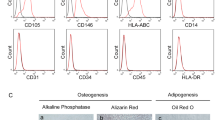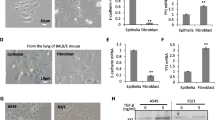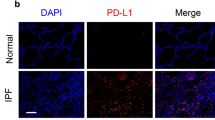Summary
Idiopathic pulmonary fibrosis (IPF) is characterized by myofibroblast foci in lung parenchyma. Myofibroblasts are thought to originate from epithelial-to-mesenchymal transition (EMT). Wnt1 and lithium chloride (LiCl) induce EMT in alveolar epithelial cells (AECs), but the mechanisms are unclear. AECs were treated with Wnt1 and LiCl, respectively; morphological change and molecular changes of EMT, including E-cadherin, fibronectin, and vimentin, were observed. SB203580 was administrated to test the role of p38 МАРК signaling in EMT. Then AECs were treated with siRNAs targeting p38 МАРК to further test the effects of p38 МАРК, and the role was further confirmed by re-expression of p38 МАРК. At last P-catenin siRNA was used to test the role of β-catenin in the EMT process and relationship of β-catenin and p38 МАРК was concluded. Exposure of AECs to Wnt1 and LiCl resulted in upregulation of vimentin and fibronectin with subsequent downregulation of E-cadherin. Wnt1 and LiCl stimulated the p38 МАРК signaling pathways. Perturbing the p38 МАРК pathway either by SB203580 or through p38 МАРК siRNA blocked EMT and inhibited fibronetin synthesis, which were reversed by transfection of p38 МАРК expression plasmid. β-catenin siRNA attenuated the EMT process and decreased p38 МАРК phosphorylation, indicating that β-catenin is involved in the EMTrelated changes through regulation of p38 МАРК phosphorylation. These findings suggest that p38 МАРК participates in the pathogenesis of EMT through Wnt pathway and that p38 МАРК may be a novel target for IPF therapy.
Similar content being viewed by others
References
Travis WD, Costabel U, Hansell DM, et al. An official American Thoracic Society/European Respiratory Society statement: Update of the international multidisciplinary classification of the idiopathic interstitial pneumonias. Am J Respir Crit Care Med, 2013,188(6):733–748
Olson AL, Swigris JJ. Idiopathic pulmonary fibrosis: diagnosis and epidemiology. Clin Chest Med, 2012,33(1):41–50
King TE, Jr., Pardo A, Selman M. Idiopathic pulmonary fibrosis. Lancet, 2011,378(9807):1949–1961
Kim KK, Kugler MC, Wolters PJ, et al. Alveolar epithelial cell mesenchymal transition develops in vivo during pulmonary fibrosis and is regulated by the extracellular matrix. Proc Natl Acad Sci USA, 2006,103(35): 13180–13185
Betensley A, Sharif R, Karamichos D. A Systematic Review of the Role of Dysfunctional Wound Healing in the Pathogenesis and Treatment of Idiopathic Pulmonary Fibrosis. J Clin Med, 2016,6(1):2
Hinz B. The myofibroblast: paradigm for a mechanically active cell. J Biomech, 2010,43(1): 146–155
Rock JR, Barkauskas CE, Cronce MJ, et al. Multiple stromal populations contribute to pulmonary fibrosis without evidence for epithelial to mesenchymal transition. Proc Natl Acad Sci USA, 2011,108(52):E1475–1483
Tanjore H, Xu XC, Polosukhin W, et al. Contribution of epithelial-derived fibroblasts to bleomycininduced lung fibrosis. Am J Respir Crit Care Med, 2009,180(7):657–665
Li LF, Lee CS, Lin CW, et al. Trichostatin A attenuates ventilation-augmented epithelial-mesenchymal transition in mice with bleomycin-induced acute lung injury by suppressing the Akt pathway. PLoS one, 2017,12(2):e0172571
Moon RT, Kohn AD, De Ferrari GV, et al. Wnt and beta-catenin signalling: diseases and therapies. Nat Rev Genet, 2004,5(9):691–701
Gordon MD, Nusse R. Wnt signaling: multiple pathways, multiple receptors, and multiple transcription factors. J Biol Chem, 2006,281(32):22429–22433
Wang C, Zhu H, Sun Z, et al. Inhibition of Wnt/betacatenin signaling promotes epithelial differentiation of mesenchymal stem cells and repairs bleomycininduced lung injury. Am J Physiol-Cell Ph, 2014,307(3):C234–244
Konigshoff M, Balsara N, Pfaff EM, et al. Functional Wnt signaling is increased in idiopathic pulmonary fibrosis. PLoS One, 2008,3(5):e2142
Wang Y, Li YP, Paulson C, et al. Wnt and the Wnt signaling pathway in bone development and disease. Front Biosci (Landmark edition), 2014,19:379–407
Kawami M, Harabayashi R, Miyamoto M, et al. Methotrexate-Induced Epithelial-Mesenchymal Transition in the Alveolar Epithelial Cell Line A549. Lung, 2016,194(6):923–930
Mikami Y, Yamauchi Y, Horie M, et al. Tumor necrosis factor superfamily member LIGHT induces epithelial-mesenchymal transition in A549 human alveolar epithelial cells. Biochem Biophys Res Commun, 2012,428(4):451–457
Choi JH, Hwang YP, Kim HG, et al. Saponins from the roots of Platycodon grandiflorum suppresses TGFbetal-induced epithelial-mesenchymal transition via repression of PI3K/Akt, ERK1/2 and Smad2/3 pathway in human lung carcinoma A549 cells. Nutr Cancer, 2014,66(1):140–151
Kawata M, Koinuma D, Ogami T, et al. TGF-betainduced epithelial-mesenchymal transition of A549 lung adenocarcinoma cells is enhanced by proinflammatory cytokines derived from RAW 264.7 macrophage cells. J Biochem, 2012,151(2):205–216
Feng H, Liu Q, Zhang N, et al. Leptin promotes metastasis by inducing an epithelial-mesenchymal transition in A549 lung cancer cells. Oncol Res, 2014,21(3):165–171
Desai S, Laskar S, Pandey BN. Autocrine IL-8 and VEGF mediate epithelial-mesenchymal transition and invasiveness via p38/JNK-ATF-2 signalling in A549 lung cancer cells. Cell Signal, 2013,25(9):1780–1791
Bikkavilli RK, Feigin ME, Malbon CC. Galpha o mediates Wnt-JNK signaling through dishevelled 1 and 3, RhoA family members, and MEKK 1 and 4 in mammalian cells. J Cell Sei, 2008,121(Pt 2):234–245
Zheng X, Wang Y, Liu B, et al. Bmi-1 -shRNA inhibits the proliferation of lung adenocarcinoma cells by blocking the Gl/S phase through decreasing cyclin D1 and increasing p21/p27 levels. Nucleic Acid Ther, 2014,24(3):210–216
Huang J, Xiao D, Li G, et al. EphA2 promotes epithelial-mesenchymal transition through the Wnt/beta-catenin pathway in gastric cancer cells. Oncogene, 2014,33(21):2737–2747
Song P, Zheng JX, Liu JZ, et al. Effect of the Wntl/beta-catenin signalling pathway on human embryonic pulmonary fibroblasts. Mol Med Report, 2014,10(2): 1030–1036
Wei J, Li Z, Chen W, et al. AEG-1 participates in TGF-betal-induced EMT through p38 MAPK activation. Cell Biol Int, 2013,37(9):1016–1021
Jing YM, Luo J, Zhang YL, et al. Construction of a recombinant lentiviral vector of p38 MAPK and establishment of a human prostatic carcinoma cell line stably expressing p38 MAPK. Nan Fang Yi Ke DaXue Xue Bao (Chinese), 2012,32(3):317–321
Daccord C, Mäher TM. Recent advances in understanding idiopathic pulmonary fibrosis. FlOOORes, 2016,5:F1000 Faculty Rev-1046
Raghu G, Rochwerg B, Zhang Y, et al. An Official ATS/ERS/JRS/ALAT Clinical Practice Guideline: Treatment of Idiopathic Pulmonary Fibrosis. An Update of the 2011 Clinical Practice Guideline. Am J Respir Crit Care Med, 2015,192(2):e3–el9
Selman M, King TE, Pardo A. Idiopathic pulmonary fibrosis: prevailing and evolving hypotheses about its pathogenesis and implications for therapy. Ann Intern Med, 2001,134(2):136–151
Gonzalez DM, Medici D. Signaling mechanisms of the epithelial-mesenchymal transition. Sci Signal, 2014,7(344):re8
Kalluri R, Weinberg RA. The basics of epithelial-mesenchymal transition. J Clin Invest, 2009,119(6): 1420–1428
Min AL, Choi JY, Woo HY, et al. High expression of Snail mRNA in blood from hepatocellular carcinoma patients with extra-hepatic metastasis. Clin Exp Metastasis, 2009,26(7):759–767
Nawshad A, Hay ED. TGFbeta3 signaling activates transcription of the LEF1 gene to induce epithelial mesenchymal transformation during mouse palate development. J Cell Biol, 2003,163(6):1291–1301
Cano A, Perez-Moreno MA, Rodrigo I, et al. The transcription factor snail controls epithelialmesenchymal transitions by repressing E-cadherin expression. Nat Cell Biol, 2000,2(2):76–83
Peinado H, Portillo F, Cano A. Transcriptional regulation of cadherins during development and carcinogenesis. Int J Dev Biol, 2004,48(5-6):365–375
Yang J, Mani SA, Donaher JL, et al. Twist, a master regulator of morphogenesis, plays an essential role in tumor metastasis. Cell, 2004,117(7):927–939
Zhang J, Tian XJ, Xing J. Signal Transduction Pathways of EMT Induced by TGF-beta, SHH, and Wnt and Their Crosstalks. J Clin Med, 2016,5(4):E41
Bruno NE, Kelly KA, Hawkins R, et al. Creb coactivators direct anabolic responses and enhance performance of skeletal muscle. EMBO J, 2014,33(9): 1027–1043
Song P, Zheng JX, Xu J, et al. Beta-catenin induces A549 alveolar epithelial cell mesenchymal transition during pulmonary fibrosis. Mol Med Red, 2015,11 (4):2703–2710
Brandenburg J, Reiling N. The Wnt Blows: On the Functional Role of Wnt Signaling in Mycobacterium tuberculosis Infection and Beyond. Front Immunol, 2016,7:635
Ramos C, Montano M, Garcia-Alvarez J, et al. Fibroblasts from idiopathic pulmonary fibrosis and normal lungs differ in growth rate, apoptosis, and tissue inhibitor of metalloproteinases expression. Am J Respir Cell Mol Biol, 2001,24(5):591–598
Vincan E, Barker N. The upstream components of the Wnt signalling pathway in the dynamic EMT and MET associated with colorectal cancer progression. Clin Exp Metastasis, 2008,25(6):657–663
Fodde R, Brabletz T. Wnt/beta-catenin signaling in cancer sternness and malignant behavior. Curr Opin Cell Biol, 2007,19(2): 150–158
Stemmer V, de Craene B, Berx G, et al. Snail promotes Wnt target gene expression and interacts with betacatenin. Oncogene, 2008,27(37):5075–5080
Yook JI, Li XY, Ota I, et al. A Wnt-Axin2-GSK3beta cascade regulates Snail 1 activity in breast cancer cells. Nat Cell Biol, 2006,8(12):1398–1406
Takenaka K, Kise Y, Miki H. GSK3beta positively regulates Hedgehog signaling through Sufii in mammalian cells. Biochem Biophys Res Commun, 2007,353(2):501–508
Noubissi FK, Goswami S, Sanek NA, et al. Wnt signaling stimulates transcriptional outcome of the Hedgehog pathway by stabilizing GLI1 mRNA. Cancer Res, 2009,69(22):8572–8578
Caraci F, Gili E, Calafiore M, et al. TGF-betal targets the GSK-3beta/beta-catenin pathway via ERK activation in the transition of human lung fibroblasts into myofibroblasts. Pharmacol Res, 2008,57(4):274–282
Guo X, Ramirez A, Waddell DS, et al. Axin and GSK3-control Smad3 protein stability and modulate TGF-signaling. Genes Dev, 2008,22(1):106–120
Zhang Y, Dong C. Regulatory mechanisms of mitogen-activated kinase signaling. Cell Mol Life Sci, 2007,64(21):2771–2789
Xia JM, Zhang J, Zhou WX, et al. Downregulation of p38 MAPK involved in inhibition of LDL-induced proliferation of mesangial cells and matrix by curcumin. J Huazhong Univ Sci Technolog Med Sci, 2013,33(5):666–671
Xiao Y, Zou P, Wang J, et al. Lower phosphorylation of p38 MAPK blocks the oxidative stress-induced senescence in myeloid leukemic CD34(+)CD38 (-) cells. J Huazhong Univ Sci Technolog Med Sci, 2012, 32(3):328–333
Cervenka I, Wolf J, Masek J, et al. Mitogen-activated protein kinases promote Wnt/beta-catenin signaling via phosphorylation of LRP6. Mol Cell Biol, 2011,31(1):179–189
Jin EJ, Lee SY, Choi YA, et al. BMP-2-enhanced chondrogenesis involves p38 MAPK-mediated down-regulation of Wnt-7a pathway. Mol Cells, 2006,22(3):353–359
Thornton TM, Pedraza-Alva G, Deng B, et al. Phosphorylation by p38 MAPK as an alternative pathway for GSK3beta inactivation. Science, 2008,320(5876):667–670
Abell AN, Granger DA, Johnson GL. MEKK4 stimulation of p38 and JNK activity is negatively regulated by GSK3beta. J Biol Chem, 2007,282(42):30476–30484
Author information
Authors and Affiliations
Rights and permissions
About this article
Cite this article
Fang, Cx., Ma, Cm., Jiang, L. et al. p38 MAPK is Crucial for Wnt1- and LiCl-Induced Epithelial Mesenchymal Transition. CURR MED SCI 38, 473–481 (2018). https://doi.org/10.1007/s11596-018-1903-4
Received:
Revised:
Published:
Issue Date:
DOI: https://doi.org/10.1007/s11596-018-1903-4




